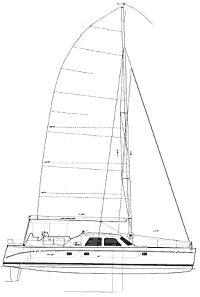Perry Cat
Multihull cruiserr
Sometimes you sit and listen to a client's want list and the first thing that jumps into your head is, "This is impossible." The more I listened, smiled and nodded to Paul the more I was convinced it was impossible. But Paul's an innovator and convincing. That's how he got to be a famous and respected guitar builder. He will run the problem through every conceivable solution, whether practical or fanciful, before giving up. And he doesn't give up.
Given the stability requirement and Paul's preference for a multihull, I chose a catamaran design based upon an earlier 55-footer I had done. With 28 feet, 10 inches of beam and 26,000 pounds of displacement we would have a stable platform. With a waterline beam for each hull of 4 feet, 6 inches we would have boat speed under both sail and power. Max hull beam is 5 feet, 9 inches, with asymmetrical daggerboards in each hull to help going to weather. These were extremely effective in my previous design. I gave the boat a flat sheerline to help with crew movement while fishing. Beauty is as beauty does.
The biggest challenge with this design was the deck layout. Paul wanted to be able to walk across the stern of the cat while fishing. This required a solid deck aft spanning both hulls rather than the typical deck cutaway between the hulls where you can tuck away a dinghy. From a design standpoint the biggest problem with this type of deck is that it moves the center of gravity aft and big cats already have a tendency to trim by the stern. I added hull volume and flattened the hull rocker aft to help deal with this. Transom rake was reduced to expand available deck space and help with the fishing requirements. With the mainsheet and boom removed, the entire aft end of the boat can be clear for fly fishing. The entire cockpit is on main deck level.
The cockpit seat/helm seat detail was designed specifically around the requirements of housing the two 14-foot, 6-inch skiffs while providing a comfy and efficient lounging and dining area. The center console houses a large ice box/reefer for fish. There is a lot of stowage in the cockpit seats. Adjacent to the cockpit dining table there are hatches in the seats to allow access to the stowed skiffs. These skiffs will be run under the stern of the boat with the driver on board. The driver will attach the skiff to the lifting mechanism then climb out through the seat hatches. That's the plan anyway. We will have to do some fine tuning once the boat is launched, but I'm convinced it can work. When the dinghies are nested snug under the deck there will be a 30-inch clearance from the skiff bottom to the water. The outboard motors will remain in the deployed position. Fun huh?
The accommodations feature staterooms for four couples, and there is an inside steering station next to a large nav station that also houses an electric piano keyboard for jam sessions on board. A large subwoofer will be housed under the dinette settee.
This was an unusual design job with an unusual outcome. I got my new guitar and I love it. Paul got a unique fishing boat. Aesthetically this boat was a challenge, and while I think the boat works well, I would hesitate to call it attractive. My hope is that when finished the bulk of the cockpit structures will be hidden by the overall bulk of the entire boat. Two-dimensional cat profiles are seldom attractive. I found it easy to bond with this boat during the design process.

Comments